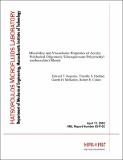Miscibility and Viscoelastic Properties of Acrylic Polyhedral Oligomeric Silsesquioxane-Poly(methyl methacrylate) Blends
Author(s)
Kopesky, Edward T.; Haddad, Timothy S.; McKinley, Gareth H.; Cohen, Robert E.
Download05-P-02.pdf (786.3Kb)
Metadata
Show full item recordAbstract
We investigate the miscibility of acrylic polyhedral oligomeric silsesquioxanes (POSS)
[characteristic size d ≈ 2 nm] and poly(methyl methacrylate)(PMMA) in order to determine the
effect of well-dispersed POSS nanoparticles on the thermomechanical properties of PMMA. Two
different acrylic POSS species (unmodified and hydrogenated) were blended separately with
PMMA at volume fractions up to φ = 0.30. Both POSS species have a plasticizing effect on
PMMA by lowering the glass transition temperature Tg and decreasing the melt-state linear viscoelastic moduli measured in small amplitude oscillatory shear flow. The unmodified acrylic-POSS has better miscibility with PMMA than the hydrogenated form, approaching complete
miscibility for loadings φ < 0.10. At a loading φ = 0.05, the unmodified acrylic POSS induces a 4.9°C decrease in the <i>T</i><sub>g</sub> of PMMA, far less than the 17.4°C decrease in the glass transition temperature observed in a blend of 5 vol% dioctyl phthalate (DOP) in PMMA; however, the decrease in the glass transition temperature per added plasticizer molecule is nearly the same in the unmodified acrylic-POSS-PMMA blend compared with the DOP-PMMA blend. Time-temperature superposition (TTS) was applied successfully to the storage and loss moduli data and the resulting shift factors were correlated with a significant increase in free volume of the blends. The fractional free volume <i>f</i><sub>0</sub> = 0.046 for PMMA at <i>T</i><sub>0</sub> = 170°C while for a blend of 5 vol% unmodified acrylic-POSS in PMMA <i>f</i><sub>0</sub> = 0.057, which corresponds to an addition of 0.47 nm<sup>3</sup> per added POSS molecule at φ = 0.05. The degree of dispersion was characterized using both wide-angle x-ray diffraction (WAXD) and dynamic mechanical analysis (DMA). Diffraction patterns for both blend systems show clear evidence of phase separation at φ = 0.20 and higher, but no significant phase separation is evident at φ = 0.10 and lower. The storage modulus measured in DMA indicates appreciable phase separation for unmodified acrylic POSS loadings φ = 0.10, while no evidence of phase separation is present in the φ = 0.05 blend in DMA.
Description
Submitted to POLYMER, January 2005
Date issued
2005-04-19Series/Report no.
05-P-02;
Keywords
POSS, plasticization, nanocomposites
Collections
The following license files are associated with this item: